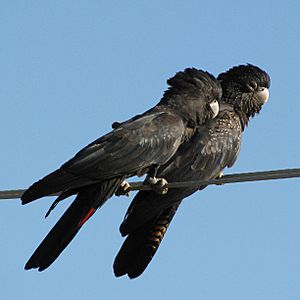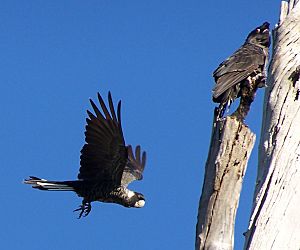Great Cocky Count facts for kids
The Great Cocky Count, also known as the Great Cockatoo Count, is a special yearly event. It helps scientists count and track black cockatoos in Western Australia. This count is the biggest survey of black cockatoos in the entire region.
It's a "citizen science" project, which means everyday people help scientists gather important information. The count happens at sunset on one night in autumn, usually in early April. It started in 2009 and has happened every year since then.
Contents
What is the Great Cocky Count?
The Great Cocky Count is like a big animal census. A census is when you count everyone or everything in a certain area. For this count, volunteers help count black cockatoos. They want to find out how many cockatoos there are and where they live. This information helps protect these amazing birds.
How Does the Count Work?
Hundreds of people volunteer their time for the count. They go to many different places across Western Australia. These places stretch from Geraldton in the north to Esperance, Western Australia in the south.
In 2014, over 450 volunteers took part. The next year, in 2015, more than 600 volunteers helped. They checked over 300 different spots. The main focus is on the endangered Carnaby's black cockatoo. But they also count the vulnerable Baudin's black cockatoo and the red-tailed black cockatoo.
What Have We Learned?
The count helps us understand how many cockatoos are left. It also shows where they like to sleep at night. In 2016, about 700 volunteers checked 426 roost sites. Roost sites are places where birds gather to sleep.
Here are some of the things they found in 2016:
- 16,392 white-tailed black cockatoos were counted at 100 roost sites.
- 1,907 forest red-tailed black cockatoos were found at 66 roost sites.
- A huge group of 4,897 Carnaby's black cockatoos were found at just one roost site!
Scientists believe that about 27% of all black cockatoos in southwest Western Australia were counted on that single night.
Why Are Cockatoos in Trouble?
The long-term results from the counts since 2009 are very important. They show that the number of Carnaby's black cockatoos is going down. In the Perth-Peel area, their population has dropped by about 15% each year.
Scientists have seen smaller groups of birds and fewer places where they roost around Perth. This is mostly because of "urban sprawl." Urban sprawl means that cities and towns are growing bigger. More houses and buildings are being built. This takes away the natural homes of the cockatoos.
A large group of Carnaby's cockatoos (46% of the population) lives in the Gnangara pine plantation. This area is planned to be cleared by 2030. Losing these trees means the birds will lose their homes and food sources. The main reason for the drop in numbers is that their breeding grounds are being cleared. Their natural areas are getting smaller. The birds are now using almost all the habitat that is left. This is barely enough to support them. The Great Cocky Count helps us see these changes and work to protect these special birds.




